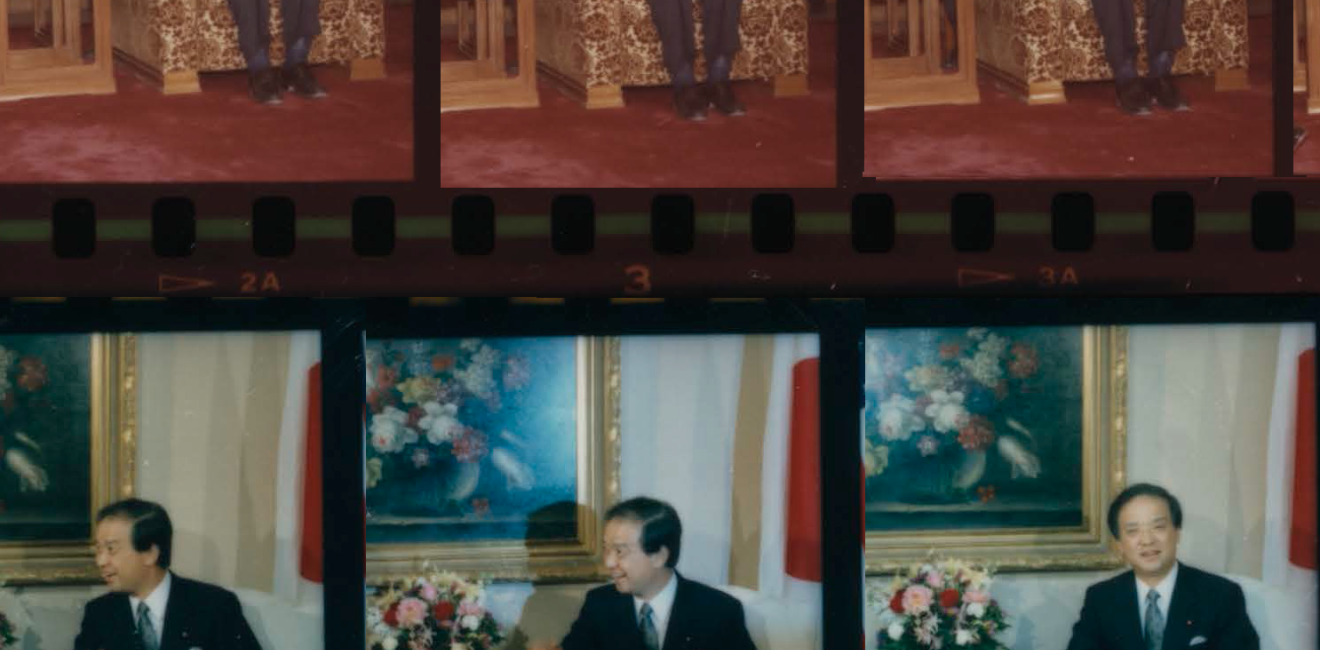Kaifu Toshiki’s August 1991 Visit to China
On August 10, 1991, Japanese Prime Minister Kaifu Toshiki touched down in the People’s Republic of China, becoming the first head of state from a G7 nation to visit the country since Tiananmen Square.

A blog of the History and Public Policy Program
On August 10, 1991, Japanese Prime Minister Kaifu Toshiki touched down in the People’s Republic of China, becoming the first head of state from a G7 nation to visit the country since Tiananmen Square.

On August 10, 1991, Japanese Prime Minister Kaifu Toshiki touched down in the People’s Republic of China, becoming the first head of state from a G7 nation to visit the country since the Tiananmen Square massacre.
Over the next three days, Kaifu met with a trio of China’s top leaders: Premier Li Peng, General Secretary of the Communist Party and Chairman of the Central Military Commission Jiang Zemin, and President Yang Shangkun. (Kaifu did not meet with Deng Xiaoping, who at that time had no formal leadership role.) The Japanese Foreign Minister, Nakayama Taro, accompanied Kaifu and met with his Chinese counterpart, Qian Qichen.
Records related to Kaifu’s visit to China were released by the Ministry of Foreign Affairs of Japan in late 2022, as part of its now annual disclosure and online publication of important diplomatic records more than 30 years old. As of writing, there are very few publicly accessible Chinese sources about Kaifu’s 1991 visit, except for contemporary state media coverage and a single entry in Li Peng’s published diary. There are also very few diplomatic reports from third party countries interested in outcome of the visit (such as the United States) presently available. The dearth of primary information about Kaifu’s visit makes these Japanese sources especially valuable for historians.
The Wilson Center’s History and Public Policy Program combed through the documents posted online by the Japanese Foreign Ministry and commissioned the English translation of several key reports, which are now accessible through the Wilson Center Digital Archive. Researchers will appreciate what the sources reveal about Sino-Japanese relations, Chinese politics and diplomacy during the “reform” era, nuclear proliferation, and post-Cold War international relations, among other topics.
Kaifu helped to break the diplomatic isolation that China had rightfully been under since June 1989, as he believed that China could no longer be left out of regional and global affairs. The two sides acknowledged Kaifu’s positive role, with Jiang Zemin, the General Secretary of the Communist Party, praising Kaifu for his efforts to have the G7 let up on sanctions against the PRC. Kaifu and his Chinese counterparts were also careful to reaffirm the importance of Sino-Japanese relations, which had “regressed somewhat since 1989,” according to Li Peng, and to ensure that the road ahead was brighter than the past few years. Jiang Zemin reflected warmly on “2,000 years of exchanges” between China and Japan.
The parties managed to reach two major agreements that boded well for the future of Sino-Japanese relations and for China’s global image.
The first, and over the long-term the most consequential, was China’s pledge that it would accede to the Treaty on the Non-proliferation of Nuclear Weapons (NPT). This development had reportedly been worked out in advance of Kaifu’s visit, so when Kaifu raised the proposal for the first time in conversation with Li Peng, the Chinese side was able to quickly announce they would join the NPT. The timing of the announcement was “an expression of…trust in Prime Minster Kaifu,” Jiang Zemin explained.
The second, hugely symbolic outcome was an agreement for the Japanese Emperor to visit China the following year to mark the twentieth anniversary of the restoration of diplomatic relations.
In the talks, Li Peng and Jiang Zemin offered primers on China’s nuclear weapons doctrine. Emphasizing China’s no first use policy, they asked for Japan to urge “some nuclear weapon states” – the United States, of course – to make the same pledge. The conversations also dwelled on the future of the international order, with both China and Japan expressing hope that the world ought to be multi-polar now that the Cold War was coming to an end.
The conversations were not entirely rosy, however. Kaifu failed to gain Chinese support for a proposed United Nations reporting system for arms sales. Both Li and Jiang also defended China’s political and economic systems when Kaifu nudged, albeit quite gently, the Chinese with regards to “‘democracy and human rights’.”
The two sides raised Taiwan several times. Li Peng asked Japan to tread carefully when it came to Taiwan; Qian Qichen demanded that Taiwan be treated as a “regional economy of China,” not as a sovereign state at Asia-Pacific Economic Cooperation (APEC) events.
North Korea was another sticking point. Li wanted Tokyo to improve relations with Pyongyang by endorsing a North Korean proposal for a nuclear-free zone on the Korean Peninsula, while Kaifu said that North Korea must follow IAEA safeguards. The record of conversation between Nakayama and Qian about North Korea is franker. Qian denied that China had provided any technology for the nuclear reactor then under construction in North Korea and said the latest developments were “a matter of great concern for China as well.” But the two sides failed to come to any sort of agreement on how best to extinguish the looming North Korean nuclear crisis.
The summaries of Kaifu’s meetings are generally brief and are not verbatim transcripts. Still, Jiang Zemin’s boisterous personality shines through. Several times with Kaifu, Jiang used Chinese proverbs (chengyu) to make a point about contemporary developments, as he had a habit of doing with both foreign and domestic audiences. When, for example, Jiang turned down Kaifu’s request to limit his country's conventional arms sales, he explained that China’s arms export industry was much smaller than that of other military powers. “There is a Chinese proverb that goes Zhi xu guojia fanghuo buxu minzhong diandeng (The magistrates are free to burn down the houses, while the common people are forbidden to even light lamps.). Such an approach is no good.”
Although the Wilson Center translated several of the most important records related to Kaifu’s 1991 visit, what is now available on the Wilson Center Digital Archive is only a fraction of a much larger corpus of materials. The full set of documents connected with Kaifu’s visit released by Japan’s Foreign Ministry in 2022 totals roughly 460 pages (available in two tranches, here and here). Aside from the conversation records, there are pre-visit planning and strategy files, internal communications within the Foreign Ministry, and handwritten memoranda, alongside a considerable number of media reports. Due to difficultly reading the handwritten summaries of Kaifu’s meeting with Yang Shangkun, these documents were not translated. Readers of the sources on the Wilson Center Digital Archive should bear these limitations in mind, and if interested take the time to review the larger body of records published by the Japanese Foreign Ministry for additional insights and details related to Prime Minister Kaifu's 1991 visit to Beijing.
Japan-China Summit Meeting (Outline) (Confidential), 11 August 1991
Li Peng and Kaifu Toshiki discuss Sino-Japanese relations, a possible visit to China by the Emperor of Japan, Taiwan, North Korea, arms control, Cambodia, Mongolia, Hong Kong, and the environment.
Japan-China Summit Meeting (Arms Control and Disarmament), 10 August 1991
Li Peng and Kaifu Toshiki discuss China's accession to the NPT, the sale of conventional arms, and North Korea's proposal for the Korean Peninsula to be declared a nuclear-free zone.
Nakayama Taro and Qian Qichen discuss Taiwan's participation in APEC, arms control, China's accession to the NPT, Sino-Japanese political and economic relations, and Chinese fishing vessels operating in Japan's territorial waters.
Nakayama Taro and Qian Qichen discuss North Korea's nuclear program.
A handwritten summary of Kaifu Toshiki’s meeting with Yang Shangkun.
A handwritten summary of Kaifu Toshiki’s meeting with Yang Shangkun.
Kaifu Toshiki and Jiang Zemin discuss Sino-Japanese relations, China's economic policy, and disaster assistance from Japan.
Kaifu and Jiang discuss Sino-Japanese relations, arms transfers, and China's accession to the NPT.
Li Peng conveys that China wishes for the Emperor of Japan to visit the country.


A leader in making key foreign policy records accessible and fostering informed scholarship, analysis, and discussion on international affairs, past and present. Read more


The Cold War International History Project supports the full and prompt release of historical materials by governments on all sides of the Cold War. Read more



